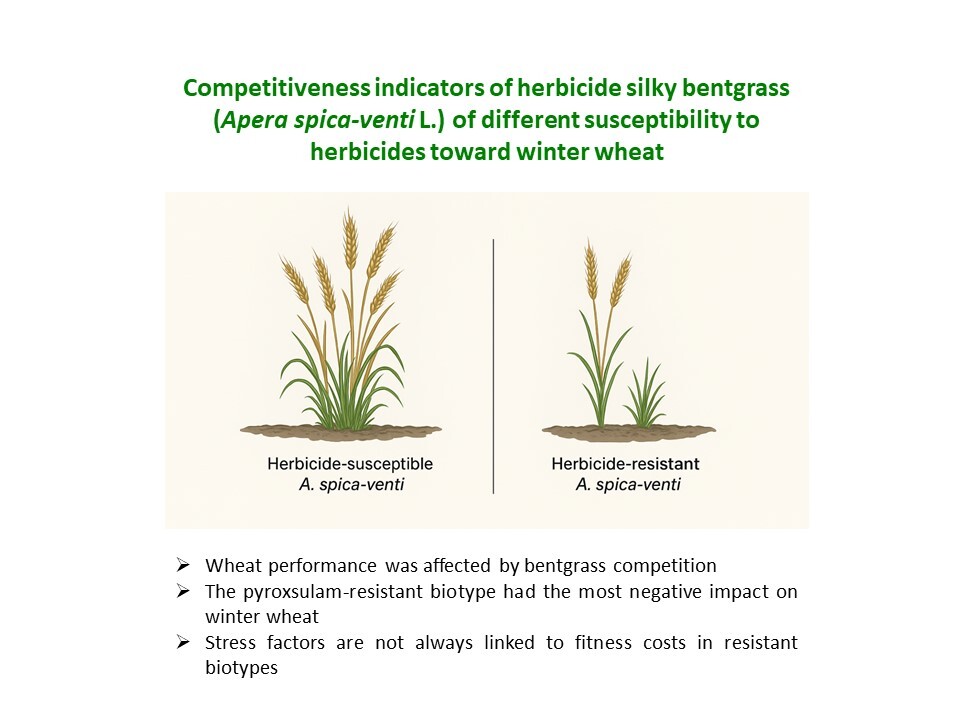ORIGINAL ARTICLE
Competitiveness indicators of herbicide silky bentgrass (Apera spica-venti L.) of different susceptibility
to herbicides toward winter wheat
1
Department of Agroecology and Crop Production, University of Agriculture in Kraków, Kraków, Poland
2
Department of Weed Science, Institute of Soil Science and Plant Cultivation – State Research Institute in Pulawy, Wrocław, Poland
3
Department of Plant Breeding, Physiology and Seed Science, University of Agriculture in Kraków, Kraków, Poland
A - Research concept and design; B - Collection and/or assembly of data; C - Data analysis and interpretation; D - Writing the article; E - Critical revision of the article; F - Final approval of article
Submission date: 2024-10-22
Acceptance date: 2025-02-19
Online publication date: 2025-09-25
Corresponding author
Mariusz Kucharski
Department of Weed Science, Institute of Soil Science and Plant Cultivation – State Research Institute in Pulawy, Wrocław, Poland
Department of Weed Science, Institute of Soil Science and Plant Cultivation – State Research Institute in Pulawy, Wrocław, Poland
Journal of Plant Protection Research 2025;65(3):386-399
HIGHLIGHTS
- The pyroxsulam-resistant biotype had the most negative impact on winter wheat
- The susceptible bentgrass biotype had no proven competitive effect on winter wheat
- Stress factors are not always linked to fitness costs in resistant biotypes
- Interspecific competitiveness may be beneficial for site-specific weed management
KEYWORDS
TOPICS
ABSTRACT
Silky bentgrass (Apera spica-venti L.) is one of Central Europe’s most troublesome monocotyledonous
weeds of winter crops. This study aimed to analyze the competitiveness of
biotypes of silky bentgrass against winter wheat, depending on the type of soil substrate
and nitrogen fertilization. In this research, in a pot experiment during two seasons, the
effect of bentgrass plants, of different sensitivity/resistance to herbicides, on winter wheat
was studied in an additive model. It was carried out on sandy or clay soil, either non-fertilized
or fertilized with nitrogen. The competitive indices were calculated based on several
wheat morphological and yield features. Multivariate analysis was incorporated to interpret
the data. As a result, it was found that wheat performance was affected by bentgrass competition.
No clear effect of soil type and nitrogen fertilization on the competitiveness of
A. spica-venti biotypes was demonstrated. Only in one season was the pyroxsulam-resistant
biotype competitive to the winter wheat when grown on fertilized clay soil. Further research
with varied numbers of winter wheat and bentgrass is advised to assess crop-weed
effects further.
FUNDING
The European Social Fund funded this research under
the Operational Program Knowledge Education Development
project entitled „Innovative program for the
strategic development of the University,” contract number
POWR.03.05.00-00-Z020/18, and the Ministry of
Science and Higher Education grant number BM 2117.
RESPONSIBLE EDITOR
Milan Brankov
CONFLICT OF INTEREST
The authors have declared that no conflict of interests exist.
Share
We process personal data collected when visiting the website. The function of obtaining information about users and their behavior is carried out by voluntarily entered information in forms and saving cookies in end devices. Data, including cookies, are used to provide services, improve the user experience and to analyze the traffic in accordance with the Privacy policy. Data are also collected and processed by Google Analytics tool (more).
You can change cookies settings in your browser. Restricted use of cookies in the browser configuration may affect some functionalities of the website.
You can change cookies settings in your browser. Restricted use of cookies in the browser configuration may affect some functionalities of the website.




